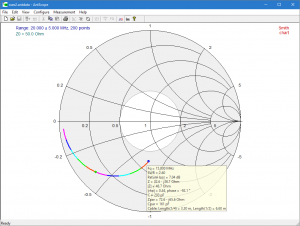Measure MLL using the Rin where X=0
Another method of estimating Matched Line Loss (MLL) from measurement is using the input resistance of a section that is an odd or even number of quarter waves in electrical length.
I say estimate because this method depend on an assumption of the value of Zo, and using purely real nominal Zo introduces some error.
The required length can be approximated by fining a frequency where X passes through zero. Again, this method is an approximation.
Simple formula
There is a simple formula published in many ham handbooks:
MLL≈8.686*Rin/Zo/length dB/unitlength
It is, a discussed at Measuring matched line loss, a crude approximation (and should be written with ≈ rather than =).
Better formula
A better formula is one I developed though it may not be novel:
MLL=-10log|(Rin-Zo)/(Rin+Zo)|/length dB/m
It is exact, but there is error introduced in using nominal Zo.
In practice
Low Z measurement
Lets measure Zin of our 4m o/c line section, and find the lowest frequency where X passes through zero, and note the value of Rin.
Above is a wide sweep, the frequency we want to focus on is around 13MHz. Continue reading Exploiting your antenna analyser #5





